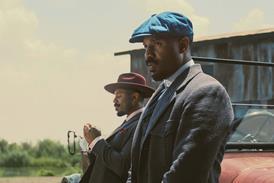Dir: Scott Derrickson.US. 2005. 118mins
An interesting but unresolved hybrid of metaphysical horror film andcourtroom drama, The Exorcism Of Emily Rose takes the true story of agirl who died in Germany following an apparent case of demonic possession, andtransplants it to small-town America.
Billed as the firstauthentic film treatment of demonic possession, Emily Rose is in one way apost-Passion horror movie, grounded in the Catholic Church's recent attempts torehabilitate exorcism. The script is sometimes clunky, especially when itpeddles coutroom cliches like the last-minute piece of evidence, and thedialogue often sounds tired. But the gothic creepiness of theDario-Argento-inspired horror sequences should satisfy fans of the genre.
The film doesn't quite havethe energy to break into first weekend topspots either at home or abroad, butit should perform respectably if the marketing people can work out a way ofconveying that, whatever the title may suggest, this is not just amouth-frothing horrorfest.
After its out of competitionscreening in Venice and North American premiere in Toronto, The Exorcism OfEmily Rose opens in the US on Sept 9.
A creepy American Gothicfarmstead somewhere in the frozen Midwest prepares the audience for horror ofthe most classic variety. When the door opens, however, we are ushered into anordinary (though rather bleak) house, inhabited by an ordinary (though ratherbleak) family.
The opening causes us toreassess our expectations; this is an early foretaste of the film's method,which is to make the horror of a 19-year-old's demonic possession more real byforcing the audience to look beyond the genre facade.
The courtroom scenes havethe same function: when ambitious blonde attorney Erin Bruner (Linney) is askedto represent Father Moore (a typecast Wilkinson), a Catholic priest accused ofcontributing to the death of Emily Rose (Carpenter) by choosing spiritualhealing over prescription drugs, she decides that the only reasonable line ofdefence is to prove that demonic possession can exist - if you believe in it.
As in Kurosawa's Rashomon,a horrific death is held up for post-mortem examination in an attempt to provethat there is more than one side to every story. The problem is that the needto respect the horror genre conventions too often buries the film's quest forthe truth in hokum.
When yet another characteris woken up just as the green LED of the bedside clock is flashing 0300 (thewitching hour, the script would have us believe), we get to wondering whetherdemons run on daylight saving time in summer: in other words, its theatricalityundermines the film's claims to be approaching the subject in an objective way.
That said, the fact thatthere is a true story behind the film not only gives out sympathy for thevictim an emotional depth that is rare in horror films, but also ensures abelievable ending (even though, dramatically, it comes as a bit of ananti-climax).
Linney can always be reliedon to inject emotional nuances into even the most conventionally written line,and she does just that here, and Carpenter is effective as the increasinglytortured and haunted Emily.
Oranges and reds dominate thepossession flashbacks, and a roving, proving camera is used to up the frightquotient, sometimes simply tracking terror, sometimes siding, we feel, with thedark forces that are causing it.
Production companies
Firm Films
Lakeshore Entertainment
US distribution
Sony Pictures
International sales
Sony Pictures Releasing International
Executive producers
Andre Lamal
Terry McKay
David McIlvain
Julie Yorn
Producers
Tom Rosenberg
Gary Lucchesi
Screenplay
Paul Harris Boardman
Scott Derrickson
Cinematography
Tom Stern
Production design
David Brisbin
Editor
Jeff Betancourt
Music
Christopher Young
Main cast
Laura Linney
Tom Wilkinson
Campbell Scott
Jennifer Carpenter
Colm Feore
Joshua Close



















No comments yet